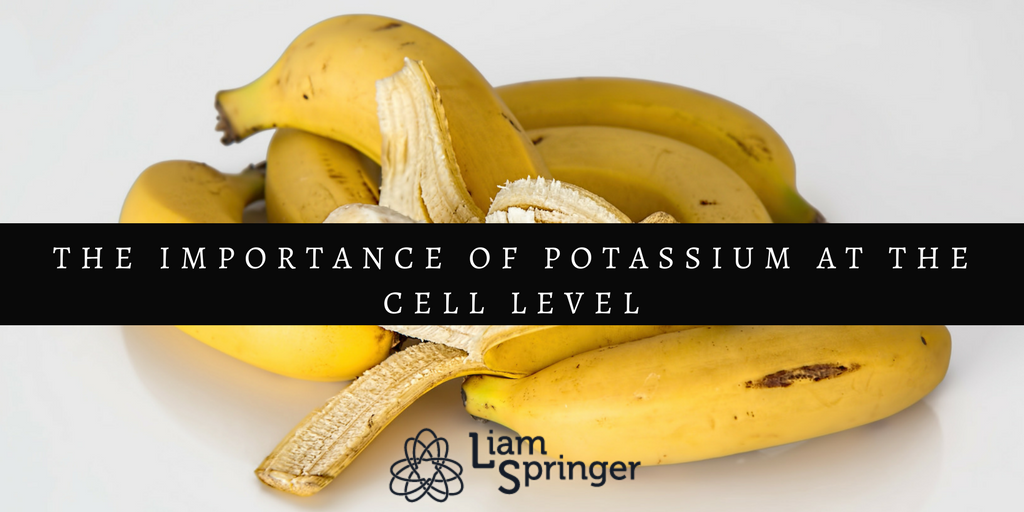
Potassium is one of the primary mineral elements contributing to the metabolic processes of the biological system. This means it is one of the most essential components of life. In this post, I explore the importance of potassium at the cell level. Keep reading to learn about the delicate balance of potassium and sodium inside and outside the cell, as well as the significant role that potassium plays in times of stress and fatigue.
The Potassium Gradient and How It’s Maintained
Potassium is considered one of the electrolytes, which means it contributes to the movement of electrons within biochemical interactions. It is understood that there is a constant gradient of potassium across the cell boundary. This means there is a higher potassium to sodium ratio inside the cell and a higher sodium to potassium ratio outside the cell. There are many special actions that maintain this important feature of the organism. For one thing, the kidneys selectively excrete potassium and the cells selectively retain potassium in order to maintain a balance between the two minerals.
Proton-Potassium Pump Hypothesis
The mechanism by which the cell excludes more sodium than potassium in order to maintain an electron gradient and allow the important charge which keeps the living cell viable is proposed to be an ionic pump embedded within the protein shell of the cell. This hypothesis, however, is not confirmed via microscopy. And it is challenged by a competing hypothesis—one that better satisfies the physical need for energy to maintain the gradient.
Association Induction Hypothesis
Association induction hypothesis (proposed by Gilbert Ling and expanded and confirmed by the work of Gerald Pollack) proposes that potassium is held within the cell via natural attraction of protein surfaces, and that sodium is excluded via a specialized state of structured water produced by protein surfaces that exist within the living cell. This is important because it shows that:
- The presence of potassium is essential to the actions that maintain life.
- A healthy cell can maintain these mineral gradients more easily than an exhausted cell.
As the body becomes fatigued, potassium will be lost from the intracellular region and removed from the body via the kidneys in order to protect the potassium to sodium ratio from becoming too high in the extracellular space.
The Importance of Potassium and ATP in Times of Fatigue
When the body is fatigued from any of the five types of stress—physical, mental, emotional, nutritional, or toxic—the cell can become deficient in ATP (a.k.a. the “molecular currency” of intracellular energy transfer). The presence of ATP is a major regulator of the state of the protein surfaces which maintain the potassium gradient. The more quickly the potassium and ATP can be made present within the cell, the faster the viability of the cell can be restored.
The most efficient method of producing ATP is oxidative phosphorylation, which is improved by the presence of potassium. This process requires glucose and oxygen to be brought into the cell and delivered efficiently to the mitochondria for the manufacturing of the ATP molecule from ADP and free phosphate. So, by increasing the presence of glucose and potassium in the presence of oxygen, the viability of the cell can be restored. The release of glucose into the blood by the liver is the primary source of glucose in the face of fatigue presented by a stressful challenge. And the potassium in the blood travels with glucose into the cell in tandem. In fact, increased potassium in the blood improves the delivery of glucose independent of the amount of insulin present.
In times of fatigue or exhaustion, the importance of potassium is clear. Potassium plays an essential role in restoring cell vitality and protecting against degenerative stress.
What About Potassium in the Diet?
Now that you understand the importance of potassium, you may be curious about how to incorporate this essential mineral into your diet. Foods that are rich in potassium and that aid in the storage of glycogen are particularly helpful in protecting the body against extended periods of fatigue or exhaustion. For more info, stay tuned for my next post, which will go into much more detail about potassium rich foods.
For more insights on the latest topics in health and nutrition, sign up for my monthly newsletter. Want to try a new exercise method that’s great for pain management, strength and stability, and flexibility? Go to BTMAStudios.com to learn about the ELDOATM method, or go to Yoga Source to sign up for classes now.
Suggested Reading
Gilbert Ling’s explanation of potassium retention across cell “membrane” against a gradient: http://www.i-sis.org.uk/Electronic_Induction_Animates_the_Cell.php






